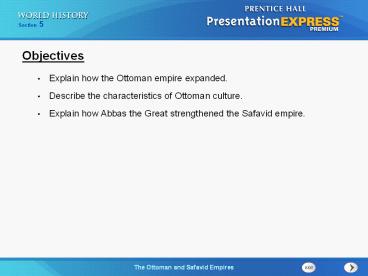PresentationExpress - PowerPoint PPT Presentation
Title:
PresentationExpress
Description:
Objectives Explain how the Ottoman empire expanded. Describe the characteristics of Ottoman culture. Explain how Abbas the Great strengthened the Safavid empire. – PowerPoint PPT presentation
Number of Views:83
Avg rating:3.0/5.0
Title: PresentationExpress
1
Objectives
- Explain how the Ottoman empire expanded.
- Describe the characteristics of Ottoman culture.
- Explain how Abbas the Great strengthened the
Safavid empire.
2
Terms and People
- Ottomans Turkish-speaking nomadic people who
migrated from Central Asia to establish an empire
from Istanbul - Istanbul formerly Constantinople Ottoman
capital - Suleiman sultan during the Ottoman golden age
extended their rule deep into Europe - janizary elite force of the Ottoman army
- Safavid Shiite Muslim dynasty founded an
empire in present-day Iran
3
Terms and People (continued)
- shah Safavid king
- Shah Abbas king of Safavid empire from 1588 to
1629 centralized the government - Isfahan new capital built by Shah Abbas became
the center of the international silk trade - Qajars dynasty that took control of Iran in the
late 1700s - Tehran new Iranian capital under the Qajars
4
What were the main characteristics of the Ottoman
and Safavid empires?
Between about 1450 and 1650, the Ottoman and
Safavid empires dominated the Middle East and
parts of Eastern Europe. They owed much of their
success to new weapons, which helped them create
strong central governments.
5
In 1452, Mehmet II began a 52-day siege of
Constantinople. After pounding the walls with
cannon fire, he finally defeated the
city. Renamed Istanbul, the city became capital
of the Ottoman empire.
- The Ottomans were a Turkish-speaking people from
Central Asia.
- From their new capital the Ottomans moved into
Asia Minor and the Balkans.
6
The Ottoman and Safavid Empires
7
- Suleiman extended Ottoman rule into the Middle
East. - He invaded as far west as Vienna.
- His empire stretched from Hungary to Arabia and
across North Africa.
The golden age of the Ottomans was during the
reign of Suleiman the Magnificent, 1520
to 1566.
8
Suleiman took the titles of emperor and
protector of the sacred places (Mecca and
Medina) he was also known as the lawgiver.
- He was a fair but absolute leader who improved
the justice system. - He ruled using a council of advisors called
viziers. - Ottoman law was based on Sharia.
9
Ottoman society was organized into four classes
Men of the sword Soldiers who defended the
sultan and the state
Men of the pen Scientists, judges, lawyers, and
poets
Men of negotiation Merchants, tax collectors,
and artisans
Men of husbandry Farmers and herders who
produced the food
10
People were also divided into religious
communities called millets.
11
The Ottomans recruited officers for the army and
government from among those they conquered.
- In the Balkans, Christians were taxed by
turning over their sons for government service. - Some were converted to Islam and put through
military training. The best won a place in the
janizaries. - Bright students were educated to be officials in
the government.
12
Non-Muslim girls were also forced into service,
often enslaved to work in the households of
wealthy Muslim families.
- They might be accepted as members of the
household. - They might be freed upon the owners death.
13
The arts flourished under Suleiman.
- Poets adapted Persian and Arab models to Turkish.
- Royal architect Sinan created beautiful mosques.
- Painters created detailed illuminated manuscripts
and miniature paintings.
14
The Ottoman empire began a slow decline following
Suleimans death in 1566.
- Suleiman had executed his two most able sons,
whom he suspected of treason.
- His successor, Selim II, left most governing to
his ministers. The bureaucracy grew corrupt.
- European nations and Russia took Ottoman land.
North Africans broke away.
15
By the early 1500s, the Safavid dynasty had
arisen in Persia (present-day Iran).
Caught between Mughal India and the Ottoman
empire, they were frequently at war. The Safavids
were Shiite Muslims the Sunni Ottomans
considered them heretics.
16
Shah Abbas the Great (15881629) revived the
glory of ancient Persia.
- He centralized the government, created a powerful
military, and negotiated alliances with European
enemies of the Ottomans.
- He helped the economy by reducing taxes on
herders and farmers and encouraging industry.
17
Abbas tolerated non-Muslims and valued their
economic contributions.
- He built a new capital at Isfahan and invited the
Armenian Christians, who controlled the silk
trade, to Isfahan. - Isfahan became the center of the silk trade the
Armenians were allowed to live outside the
capital and to govern themselves.
18
After the death of Abbas a power struggle arose
and the Safavid dynasty declined.
Shiite scholars challenged the political
authority of the shahs (Safavid kings).
19
The Safavid left a lasting impact, establishing
Shiism in Iran and providing Persians with a
sense of identity.
In the late 1700s, a new dynasty, the Qajars,
took control of Persia.
The Qajars made Tehran their capital and ruled
until 1925.
20
Section Review
Know It, Show It Quiz
QuickTake Quiz































